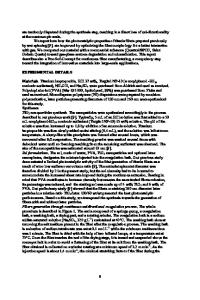ZnO/PVA Macroscopic Fibers Bearing Anisotropic Photonic Properties
- PDF / 4,028,540 Bytes
- 6 Pages / 612 x 792 pts (letter) Page_size
- 49 Downloads / 298 Views
ZnO/PVA Macroscopic Fibers Bearing Anisotropic Photonic Properties Natacha Kinadjian,1,3 Marie-France Achard,1 Beatriz Julian-Lopez,2 Maryse Maugey,1 Philippe Poulin,1 Eric Prouzet3 and Rénal Backov1* 1 Centre de Recherche Paul Pascal, office 115, UPR 8641-CNRS, 115 Avenue Albert Schweitzer, 33600 Pessac, France. 2 Department of organic and inorganic chemistry ESTCE - Universitat Jaume I. Avda. Sos Baynat s/n, 12071 Castellón, Spain. 3 Department of Chemistry & Waterloo Institute of Nanotechnology, University of Waterloo, 200 University Avenue West, Waterloo, Ontario, Canada N2L 3G1. ABSTRACT Composite PVA/ZnO-nanorods fibers, synthesized through co-axial flux extrusion exhibit higher anisotropic photonic properties, both in absorption and emission, as a result of the collective alignment of the ZnO nanorods along the main axis of the PVA fiber. This photonic anisotropy is triggered by a synergistic interaction between the PVA matrix, stretched above Tg, and cooled down under strain. Compared with non-elongated fibers that present an isotropic emission, composite fibers previously submitted to a tensile stress absorb selectively UV emission when the polarized laser beam is parallel to the main axis of the fiber. In addition, their photoluminescence is also anisotropic, with a waveguide behavior along the fiber’s main axis. INTRODUCTION Zinc oxide represents intrinsically a promising material for ultra-violet nanooptoelectronic devices and lasers operating at room temperature [1]. Considering the morphology of ZnO, a tremendous amount of nanostructures has been obtained [2-4]. Properties of ZnO regarding the absorption and emission properties are well-known [5]. As measurements on a single nanorod are difficult [6], being able to align a whole population of ZnO nanorods along a single axis, is a better way to evaluate the macroscopic effect of collective alignment. As a result, we investigate the response of a collection of nanoparticles through preferential orientation. The association of micro-extrusion and gelling mechanisms, allowed us to achieve the preparation of carbon nanotubes [7], and vanadium oxide macroscopic containing composite fibers [8,9]. In this study, we report a new method for the preparation of PVA/ZnO-nanorods composite fibers. We demonstrate that the additional order resulting from the micro-extrusion and specific post-alignment, provides an additional level of anisotropy for photonic properties as a result of an optimized alignment of the ZnO nanorods within the fibers. This behavior could be interesting, for example, for switching devices based on this type of semiconductor. EXPERIMENT Fibers Synthesis Figure 1 presents the fibers synthesis process. ZnCl2.H2O, N2H4.H2O, Poly-Vinyl alcohol PVA and Na2SO4 were purchased from Aldrich and used as received. Synthesis of ZnO nanorods was inspired from Zhu et al [10].
b)
a)
c)
10µm
Figure 1. Overall synthetic path. a) as-synthesized TEM picture of ZnO particles b) typical extrusion of the solution into a rotating beaker containing a Na2SO4 sat
Data Loading...









